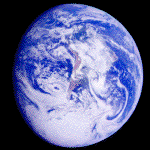
Chapter 9: Daisyworld - or "GAIA redux"
"The only bad theories are those that cannot be questioned or tested" (James Lovelock)
You have by now read most of James Lovelock's book "Gaia - a new look at life on Earth", and have read about his key thesis that organic life was not a passive passenger on the third rock from the sun, but had an active role in shaping the Earth's climate and atmospheric conditions.
The Origin of the Gaia Hypothesis
Ironically, work on the GAIA hypothesis started with an exploration of outer space. In the
mid-1960's, Dr James Lovelock was approached by NASA , who asked him for help in searching
for life on Mars (the Viking lander program). In 1965, Lovelock proposed some physical
tests for determining whether Mars held life or not. He proposed that a top-down view of
the entire planet be employed. The test would analyze the composition of the planet's
atmosphere. If it held no life, the planet should have an atmosphere close to the chemical
equilibrium state, as determined by chemistry and physics. If the planet held life, the
metabolic activities of life-forms would result in an atmosphere far from the equilibrium
state. Together with scientist Dian Hitchcock, Lovelock examined the atmospheric data for
the Martian atmosphere and found it to be in a state of stable chemical equilibrium, while
the Earth was shown to be in a state of extreme chemical disequilibrium. The two
scientists concluded that Mars was probably lifeless; almost a decade later the Viking 1
and 2 landings conformed their conclusion.
 |
At about the same time Lovelock began to think that such an unlikely combination of gases as found in the Earth's atmosphere indicated a homeostatic condition. He assumed that the Earth's biosphere was responsible to maintain environmental conditions conducive for life, in a sort of cybernetic feedback loop, an active control system. This control, however, is non-teleological, meaning that there is no "conscious" intent or pre-set purpose on part of the biosphere. Lovelock first proposed this idea to a scientific audience in 1972, and later expanded on it in collaboration with American microbiologist Lynn Margulis (she introduced the idea that microorganisms/cells could acquire new capabilities through assimilation of symbionts, a revolutionary thought at the time). In 1979 Lovelock published the book you have been reading "Gaia - a new look at life on Earth", and presented the Gaia hypothesis to the wider public. |
The Nature of Gaia
As defined by Lovelock in his book: "The name of the living planet, Gaia, is not a
synonym for the biosphere. The biosphere is defined as that part of the Earth where living
things normally exist. Still less is Gaia the same as the biota, which is simply the
collection of all individual living organisms. The biota and the biosphere taken together
form part but not all of Gaia. Just as the shell is part of a snail, so the rocks, the
air, and the oceans are part of Gaia. Gaia...has continuity with the past back to the
origins of life, and extends into the future as long as life persists. Gaia, as a total
planetary being, has properties that are not necessarily discernible by just knowing
individual species or populations of organisms living together".
The Gaia hypothesis...suppose(s) that
the atmosphere, the oceans, the climate, and the
crust of the Earth are regulated at a state comfortable for life because of the behavior
of living organisms. Specifically, the Gaia hypothesis said that the
temperature,
oxidation state, acidity and certain aspects of the rocks and waters are at any time kept
constant, and that this homeostasis is maintained by active feedback processes
that are operated
automatically and unconsciously by the biota. Solar energy sustains comfortable conditions
for life. The conditions are only constant in the short term and evolve in synchrony with
the changing needs of the biota as it evolves.
We have by now already explored some of the aspects of the Earth's atmosphere, such as its persistent chemical disequilibrium (O2 with CH4 for example), and the biological modulation of trace greenhouse gases (CO2, CH4, N2O). These very aspects suggested to Lovelock and his associates that the Earth might be a sort of "superorganism", a self-regulating system that keeps conditions on Earth in the comfort zone for life (as we know it). The hypothesis caused a stir and was initially dismissed by many scientists because it seemed to require that purpose and planning sprang from the interaction between water, air, microbes, etc. Also, the fact that "New Age" spiritualists also have a world view of a "living Earth" did not exactly endear this hypothesis to the scientific community. Lovelock developed the Daisyworld model to prove to his critics that purposeful action by the biosphere was not required for temperature regulation, but that instead that processes of natural selection were sufficient to accomplish the task of temperature regulation.
Although the Earth is too complex a system to be modeled mathematically (at least not
yet), what we can do is to construct a simplified model in which much of the complexity
has been stripped away and only the fundamental relationships and characteristics are
retained. While it may not tell us exactly how life on Earth would modify climate in
detail, it may still be able to tell us at least whether it can influence climate at all.
Daisyworld
is such a model.
Life on
Daisyworld has been reduced to just two kinds of
daisies of different colors, and the only environmental condition that affects the daisy
growth rate is temperature. The temperature in turn is modified by the varying amounts of
radiation absorbed by the daisies. We know from experience that dark surfaces get much
hotter in the sun than light surfaces. Likewise,
black daisies do not reflect much
sunlight back into space and transform sunlight in long wavelength thermal radiation (the
Earth surface gets warmer), whereas
white daisies have the opposite effect (they
reflect
most of the sunlight back into space and thus prevent warming of the Earth surface).
The basic premise for Daisyworld is this:
The mean temperature of Daisyworld is determined simply by the average shade color of the planet (or albedo). If the surface is a dark shade (low albedo) it absorbs more heat from the sun, and if it is a light shade (high albedo) it absorbs less and stays cooler. Let us assume now a time in early Daisyworld when the sun was relatively cool, and the equatorial regions were just barely warm enough to exceed the 5 degree threshold for daisy growth. The first crop of daisies contained both the black and white type, but in areas where black daisies were abundant the temperatures were raised, and where the white daisies were abundant the temperatures were lowered. As a result, the black daisies would have prospered and made lots of seeds, whereas the white daisies would mostly have died and produced fewer seeds. The following years would see a planet surface increasingly dominated by black daisies, further raising the surface temperatures. What we have here is a positive feedback loop. Once the surface temperatures rise above the optimum for daisy growth, the further expansion of daisies would slow down because of smaller seed production (now we have negative feedback). Also, the white daisies would become more abundant as temperatures rise, because they can keep cool when it gets too warm for black daisies. Over time, with increasing solar output, the proportion of daisies will shift more and more towards the white variety, and eventually they will not be able to cope with the incoming heat any more and all daisies die.
Daisyworld is obviously a gross simplification of the real earth. However, it does retain the central feature of interest: a feedback loop between the climate and life on the planet. Since the equations governing the system will be correspondingly simplified, it will allow us to investigate under what conditions, if any, that equilibrium is reached. The hope is that this will then gain us some insight into how life on the real earth may lead to a stable climate. The equations that govern Daisyworld have been published in various places, but for the purpose of this class we will assume that the published computer models are correct and simply look at the result of various Daisyworld simulations.
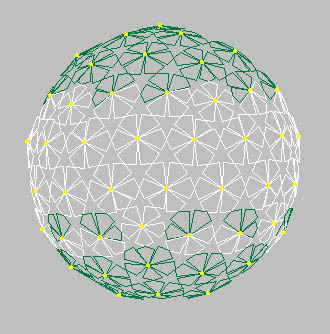 |
Because due to the spherical nature of the Earth the equator will always receive more heat than the polar regions (see chapter 4), conditions should in general be more hospitable to white daisies around the equator, and black daisies should have an advantage in the polar regions. Thus, we will get a latitudinal zonation of daisies, as seen in the picture to the left. |
Exploring Daisyworld
The response of Daisyworld to gradually increasing solar output that we outlined above is even more amazing when we look at a computer simulation of surface temperature development.
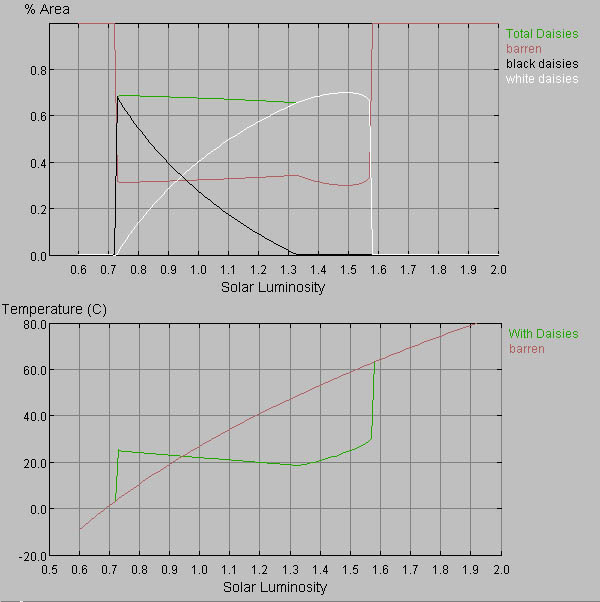
A Daisyworld simulation for a time span (as a function of solar luminosity) of
something like 10 billion years.
We see that once temperatures reach the level when daisies can grow at all, there is a rapid increase to the "comfort level" (20 degrees) and the daisies occupy a large portion of the planet surface. Actually, we are a little above optimum, and the negative feedback characteristics of the system take over. The good thing about this is that negative feedback keeps our system in homeostatic balance. We also see that as time goes by the abundance of black daisies declines and that this decline is matched by an increase in white daisies. At some point the solar output (and surface heating) becomes so large that black daisy colonies will right away overheat, and thus they die out (at solar luminosity of 1.32) and have to leave temperature regulation to the white daisies. Eventually the capacity of the white daisies to reflect sunlight is overpowered by the growing solar output. Basically, once the white daisies have colonized all the available surface area the game is over, temperatures shoot up and all daisies die.
The cool thing is that even though the daisies had no consciousness about all this, the forces of natural selection (favoring either white or black daisies depending on solar output) caused the two daisy types to (inadvertently) regulate global temperatures at a level comfortable to the daisies, even though the amount of heat that was arriving from the star steadily increased.
SIM-Earth
We can also experiment with Daisyworld by causing sudden changes in some variables and see how the system reacts. The easiest way to do this is by using a computer model of planetary self-regulation (SIM-Earth), that also contains a Daisyworld variant (SIM-Earth was written by the same people that produced the popular video game SIM-City, in cooperation with James Lovelock). SIM-Earth works with a larger variety of daisies (7 shades instead of 2), but the result is nonetheless the same.
The image below is the SIM-Earth terrain map,, showing land and sea distribution in a Daisyworld simulation.
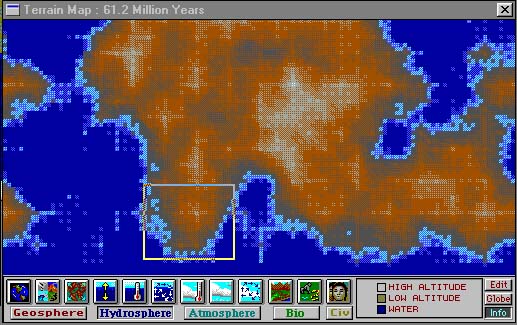
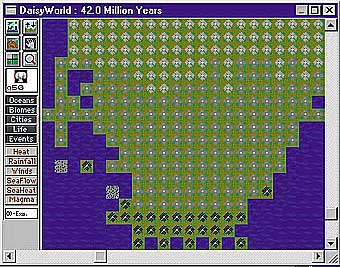 |
The rectangular box in the Terrain map above locates a detail view of the planet
surface (see image to the left) and shows us what kind of daisies grow there. We see
that as we go to higher and higher latitudes, the daisies get darker and darker.
This reflects the fact that heating is greatest at the equator, and least at the poles. In the Biome map (see below) we see the global distribution of daisies of different shades of gray, and see the brightest ones at the equator, and the darkest ones near the poles. |
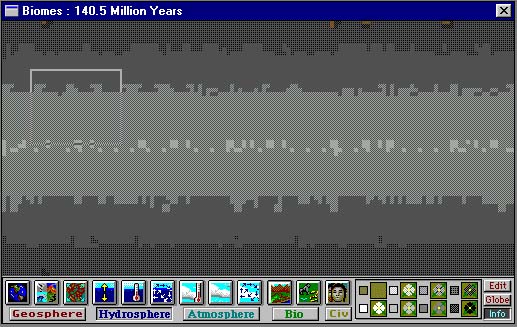
Tracking the temperature history (image below), we can see that after an initial spike (the first wave of black daisies causes the temperature to shoot up) the temperature settles down to a fairly uniform level. The simulation would run until we exhaust the reflection capacity of the white daisies, and then the temperature would shoot up like in the earlier shown simulation.
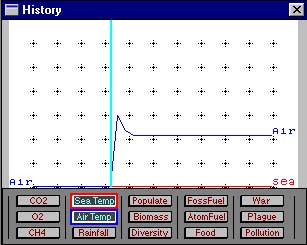
We can use the model to explore a variety of disturbances of the system, and will invariably find that the simple temperature regulation mechanism that is modeled here is highly effective to keep Daisyworld comfortable for daisies.
How will Daisyworld react if we play god and suddenly increase solar luminosity? Follow this link to find out.
Towards a bit more Realism
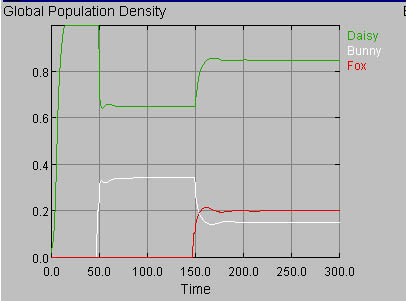
Ecosystems are usually a bit more complicated than just a system of two daisies, and therefore the Daisyworld model has also been explored with respect to factors that negatively affect the daisies, like the introduction of plant eating bunnies. Using equations from modern ecosystem dynamics research, we find (diagram above) that this has an impact. The population of daisies decreases, but a new balance is established between the grazers and the grazed. We can complicate things further by making life miserable for the grazers through the introduction of foxes. Now the bunny population drops, the fox population increases, and then the two stabilize again at a new dynamic equilibrium level. Because the foxes keep down the number of bunnies the daisy population increases until it stabilizes again. All three species settle down to a new homeostatic equilibrium.
We can further complicate things by once in a while causing an unexpected disturbance like a plague (see below) or a meteorite impact, and while this does cause perturbations in the temperature, things usually settle down to a steady state again.

Inn the diagrams above we see what happens when we have plagues that kill of 30% of the
daisy population. Initially, the loss of the daisies leads to a decline in rabbits
and foxes, as well as to an increase in temperature. The initial decline of the
rabbits allows daisies to increase in number again, followed by an uptick in bunnies,
which drives daisies down again, and then the system stabilizes again. We also note
that the greater the difference between the solar imposed "could be"
temperature, and the daisy stabilized "actual" temperature becomes, the greater
the temperature excursions become during one of these crises. Eventually the
disturbances can get large enough to cause a complete collapse of the system. This is so
because with the increase in the temperature differential the warm-up during these crises
(not enough daisies to regulate temperature) becomes faster and more pronounced.
What we can learn from Daisyworld
Although Daisyworld is a very simple model, it shows that there is no need for the evolution of communication between species, foresight, and planning, in order to achieve planetary homeostasis. Temperature regulation is a natural outcome (consequence) of the interaction between organisms and their environment (temperature). The model can be run with a larger number of daisy varieties (in the SIM-Earth version), but nothing fundamentally changes. Introducing further complications, such as herbivores and carnivores, causes the system to adjust at new homeostatic levels but it does not diminish the self-regulating power of the system. Basically, we could think of a model where we introduce all known species and their interrelationships, together with the equations and fluxes for the environmental variables, and we would have a real Earth simulation. Because we don't know many of these variables with sufficient precision, such a model is still decades or more likely centuries away. But our Daisyworld experience suggests that this more complex system should exhibit similar inherent stability. Thus, life on Earth is a very stable, especially if we consider that it withstood (collectively) major disturbances such as ice ages, large meteorite impacts, oceanic circulation crises, etc., and has existed uninterrupted on this planet for almost 4 billion years. Big disturbances of the system caused mass extinctions throughout earth history, many species disappeared forever, but life itself was never in serious danger. Daisyworld responds to changes in the ecological balance by moving to new homeostatic equilibria for the various species and environmental parameters.
Finally, although we can not model the global carbon cycle with sufficient precision to determine how exactly the climate is linked to it, because of the importance of the "biological pump", our Daisyworld experience suggests that the carbon cycle represents parts of the inner workings of a planet-wide climate regulation system that is driven by living organisms and serves to keep Earth's climate within the comfort zone for life.